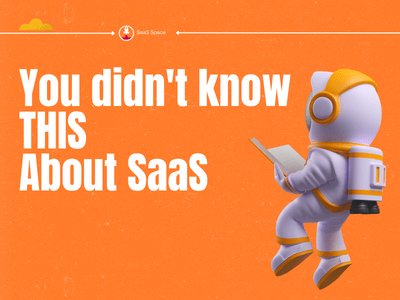When you think about what drives a successful SaaS business, what comes to mind? Maybe it’s having an innovative product. Or maybe it’s the ability to out-market the competition. Or maybe it’s owning or being part of a unicorn (we can dream, right?). All of those are pretty neat, but none of them guarantees long-term success. What truly sets SaaS companies apart today is something you might overlook—customer experience (CX).
Customer experience isn’t just about having friendly customer support or a flashy onboarding process. It’s how your customers feel when they interact with your business at every touchpoint—whether through your website, product interface, or a late-night email exchange with your support team.

For SaaS companies, delivering great experiences is required for growth. Since many operate on subscription models, even the best product can’t thrive without customers who stick around. And guess what keeps them loyal? A seamless, personalized, and engaging experience.
If you’re serious about growing, scaling your customer experience strategy should be at the top of your to-do list. Here’s how to get it done.
Why Scaling Customer Experience Matters For SaaS Growth
You’ve worked hard to win over new customers, but growth isn’t just about acquisition. Retention plays a bigger role in sustainability, especially in the SaaS game. Scaling CX makes every customer feel valued and connected to your product, no matter how large your company grows.
The following explains why it is so important to the achievement of your SaaS business:
- Retention is Revenue: Churn is the silent killer for SaaS businesses. If you’re losing customers faster than you acquire them, you’ll never maintain growth. CX activities that are focused and scalable may significantly lower churn by maintaining customer satisfaction and engagement.
- Word of Mouth Cuts Costs: Great customer experiences don’t just keep your existing customers happy. They turn them into brand advocates. Today’s customers trust referrals and reviews more than traditional advertising. Scaling CX minimizes the need to stretch your marketing budget because happy customers will spread the word.
- Upsells Depend on Relationships: When customers feel heard and supported, they’re more likely to upgrade their plans, buy add-ons, or extend their contracts. Scaling CX improves customer success outcomes and strengthens these revenue streams.
Let’s look at a hypothetical example. You have developed horizontal marketing software for eCom businesses. It doesn’t matter if they’re selling furniture or allowing people to design slides online, the product works the same for everyone.
What will set you apart from the ocean of other startups out there is how well you treat them all, regardless of what they’re doing or how they’re doing it.
Using Tech to Strengthen the Customer Experience
Technology empowers you to scale customer experience without burning out your team or overloading your resources. The aim is to increase the effectiveness of your human touch delivery, not to replace it. What does that mean? It means AI. Duh. Let’s get into it.
Here are the tools that can help make scaling CX manageable and impactful:
- Chatbots: Tools like Gorgias and Tidio can help you provide real-time responses to customer queries 24/7 while providing a seamless handoff to your human team for complex issues.
- CRM Platforms: HubSpot, Salesforce, or similar tools allow you to track customer interactions, personalize communications, and identify where customers are in their journeys. A CRM for sales teams ensures that every touchpoint is optimized, helping sales reps build stronger relationships while streamlining follow-ups and deal management. In many cases, connecting tools that teams already use daily can simplify this even further. For example, implementing email integration for Salesforce allows calendar events and email threads to sync naturally, reducing manual coordination and helping avoid missed follow-ups.
- Product Analytics: Tools like Mixpanel or Pendo track how users interact with your interface, pinpointing struggles and drop-off points. With this data, you can proactively eliminate friction and keep users engaged.
- Customer Feedback Systems: Net Promoter Score (NPS) tools help gather feedback and highlight areas where your experience might fall short. Form builders also play a key role in this process, and exploring Jotform alternatives can give SaaS companies flexible options for creating customer surveys, onboarding questionnaires, and feedback forms that enhance the overall experience.
Technology won’t solve everything. It’s unfortunate but true. However, it will help you scale more efficiently while delivering the care and attention every customer deserves.
Successful SaaS Companies that Prioritize Customer Experience
Theory is nice, but real-world examples drive the point home. Excellent customer service has been the foundation for the expansion of some of the most profitable SaaS businesses.
- Slack – Slack does more than just streamline communication. They’ve mastered onboarding by ensuring their product is intuitive while offering immediate support. Their proactive CX strategies—like personalized tips sent after signup—ensure new users get value from day one.
- Zendesk – These guys took customer support to another level. And they practice what they preach. Their approach to onboarding and support emphasizes empathy and speed, resulting in a highly loyal customer base. They also use behavioral analytics to anticipate users’ needs before they even make a formal request.
- Canva – Canva puts simplicity first by offering an interface that’s so intuitive most users don’t need tutorials. But if help is needed, their blog, community forums, and help center provide an outstanding self-serve experience, ensuring users can become customers without any friction.
CX isn’t an afterthought for these companies—it’s the core of what drives adoption, retention, and advocacy.
Scaling Strategies For Your Business
Scaling isn’t as simple as adding more support staff. You’ll need to create smart, repeatable processes that work across thousands—or (hopefully) millions—of customers.
Here are strategies to consider:
- Automate Personalization – AI tools tailor onboarding flows, email campaigns, and support interactions to individual customers without requiring a massive human team.
- Proactively Engage Customers – Don’t wait for your customers to reach out. Use in-app messaging or email to provide tips, updates, or solutions based on their behavior. Additionally, utilizing co-browsing tools enables agents to work alongside customers in real time to address complex issues, significantly improving the overall user experience.
- Build a Knowledge Base – Self-service support is a win-win. People receive prompt responses, and you reduce the amount of work your support staff must do. Tools like ProProfs Knowledge Base, and Zendesk can simplify the process of creating and maintaining a knowledge base. An in-depth FAQ section is also a big deal. Help people to help themselves.
- Train for Empathy – Your team should view customers as partners. Even with technology, every human connection ought to leave the client feeling understood and encouraged.
- Measure and Iterate – Customer satisfaction surveys, NPS scores, and churn analytics give valuable insights into how to improve your customer experiences continuously.
Scaling this stuff is a marathon, not a sprint. Build processes that grow with your business and ensure your customers never feel like just another number.
The Future of Customer Experience in SaaS
SaaS is always in flux. That’s the nature of the beat. Your customer’s satisfaction, experience, and your company’s success are all tied together. Trends you should be aware of include:
- Hyper-Personalization – Customers will demand experiences tailored to their specific needs in real time. AI and machine learning will be delivering hyper-personalized interactions.
- Voice of the Customer (VOC) Initiatives – Transparency and trust will take center stage. To remain competitive, businesses will need to demonstrate that they actively listen to and act upon client input. If you don’t care, neither will the people who pay your bills.
- Seamless Multi-Channel Support – People expect support to be available across different channels—social media, email, in-app, and even video. Seamless transitions between channels will give you an edge..
Drive SaaS Growth by Valuing Your Team
SaaS startup success lies in a deep commitment to customer experience. You can build loyalty, reduce churn, and promote company growth by leveraging the right technologies, creating empathetic processes, and continuously refining how you interact with your users.
Companies like Slack, Zendesk, and Canva highlight how prioritizing CX can turn everyday customers into lifelong advocates. Scaling may be challenging, but focusing on the human element combined with innovative tools and data-driven strategies can create experiences that set your business apart.
Building a thriving SaaS business isn’t just about creating a great product—it’s about ensuring every customer interaction reinforces trust, value, and care. Don’t forget the last word in the SaaS acronym is “service”.
- Free Software Alternatives to Premium Design, Writing & Cybersecurity Tools - April 4, 2025
- 6 Best AI Human Resources Tools in 2025 - March 14, 2025
- Affiliate Software for SaaS Business - March 10, 2025


